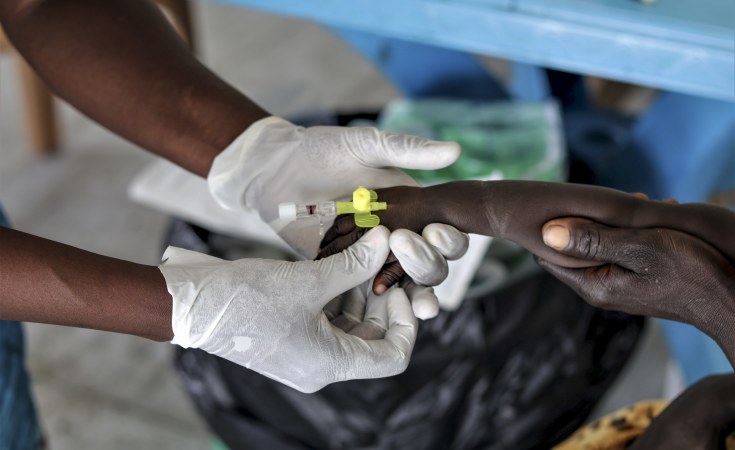Malaria remains a public health issue in Rwanda, despite collaborative efforts. However, with interventions such as mass and routine distribution of Long-Lasting Insecticide Nets (LLINs) and Indoor Residual Spraying (IRS) in high endemic districts, malaria cases in Rwanda have dropped by 88 per cent in 2023, according to Rwanda Biomedical Center (RBC).
ALSO READ: Rwanda: Malaria cases down by 88% in 2023
The Ministry of Health and RBC initiated these interventions after encountering insecticide resistance, where the standard dose of insecticides no longer effectively killed mosquitoes.
"From 2007 to 2011, we dispersed lambda-cyhalothrin and deltamethrin insecticides but noticed a resistance. RBC, therefore, extended surveillance and conducted an annual monitoring of insecticides in 2011, where the outcomes supported the course of action," said Dr Emmanuel Hakizimana, the Director of Vector Control, Malaria and Other Parasitic Diseases Division at RBC.
In 2013, a strategic plan for insecticide resistance management was developed and insecticides were used to treat bed nets, and IRS was initiated.
Hakizimana said: "We kicked off a rotation of Bazooka, a highly effective insecticide that works through contact with the ability to control insects that feed on crops.
"From 2013 to 2016, we sprayed two rounds per year using a new insecticide known as Carbamate. Still, in 2016, we introduced another insecticide 'Actellic', a persistent, broad-spectrum insecticide for controlling a wide range of insect pests in stored grain."
In 2019, RBC instigated another insecticide, Fludora Fusion, which is specifically for vector control applications. The pesticide is the first product intended for IRS campaigns combining two unrelated modes of action, such as neonicotinoid insecticide clothianidin and pyrethroid insecticide deltamethrin.
To date, RBC rotates between Actellic and Fludora fusion but other insecticides are in the pipeline, which will be used in the forthcoming IRS campaigns.
Hakizimana noted that in 2011, 40 per cent of malaria cases were prevalent in Nyagatare District, but took attention to Eastern Province. Currently, the area is now covered by IRS, and five districts of Southern Province are targeted using IRS.
In 2019, for the first time, 12 districts were covered by IRS. Today, the reduction of malaria is more than 90 per cent in terms of both malaria cases and severe malaria cases, he said.
"It is evident that it is impossible to eliminate malaria using only IRS interventions as it requires supplementation to complement the core interventions," Hakizimana noted.
Rwanda is focusing on reducing the burden of malaria in terms of severe malaria cases and deaths. By 2027, RBC will review the strategic plan to decide if they are ready for elimination or require additional time.
"We want to progressively eliminate malaria by starting with districts with low or moderate malaria cases," Hakizimana said.
The Rwanda Malaria and Neglected Tropical Diseases Annual Report 2020-2021 states that from July 2020 to June 2021, biological resistance tests were carried out in 30 different sites.
The tests followed the WHO mosquito susceptibility guidelines using the cylindrical tube method for the eight insecticides belonging to the four classes including; Carbamates, Organophosphates, Organochlorines, Alpha cypermethrin, and the new class of pyrrole.
Mosquitoes exposed to standard insecticide doses for one hour showed a higher prevalence of resistance to at least one insecticide in low-lying endemic districts compared to highland areas.
ALSO READ: Invasive mosquitoes could fuel malaria upsurge in Africa
IRS quality control (wall bioassays) was performed in one week, and every month, to determine the residual efficacy of the insecticide on sprayed house walls.
The IRS campaigns were performed in different periods and the districts sampled for IRS Quality Control were Gisagara, Kamonyi, Kayonza, Kirehe, Ngoma, Nyagatare, and Nyanza.
As recommended by the World Health Organization (WHO) in December 2009, Rwanda embarked on achieving the LLINs Universal Coverage (UC) of the population at risk through the LLIN mass distribution of households, and routine distribution to the most vulnerable groups (children under five years old and pregnant women).
The National Strategic Plan 2020-2024 objective is to lessen malaria morbidity by at least 50 per cent of the 2019 levels (264 deaths), and currently, deaths stand at 51 cases with a Case Fatality Rate of 6.4.
ALSO READ: Achieving a malaria-free Rwanda by 2030 is possible
The plan aims to have at least 85 per cent of the population at risk effectively protected with prevention interventions and to have correct and consistent practices and behaviours towards malaria control interventions.
According to WHO, the widespread and increasing insecticide resistance poses a threat to effective malaria vector control. Failure to mitigate and manage insecticide resistance is likely to result in an increased burden of disease, potentially reversing some of the substantial gains made in controlling malaria over the last decade.


